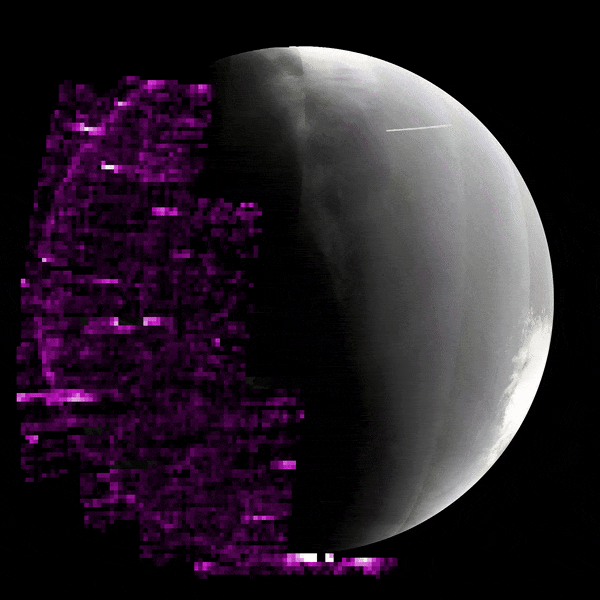Astronomy
See Ten Awe-Inspiring Images From the Astronomy Photographer of the Year Contest
Auroras, nebulas and stars take the spotlight in this space-themed competition, alongside shots of our own sun and moon
NASA Will Pay SpaceX Up to $843 Million to Destroy the International Space Station
After the end of this decade, the company will guide the aging laboratory into the Pacific Ocean, where many retired spacecrafts have been deposited
Two Massive Asteroids Will Fly Past Earth This Week. Here's What to Know
Within 42 hours of each other, the pair of large asteroids, which both have no chance of impacting our planet, will approach Earth as they orbit the sun
Jupiter's Signature Red Spot May Have Evolved More Than Once
The planet's massive storm, known as the Great Red Spot, seems to be different from a spot first observed at roughly the same location in the 17th century, a new study finds
Starliner Astronauts Will Remain on Space Station Until July Amid Technical Issues
NASA and Boeing have delayed the crewed mission's return to Earth again, as engineers assess helium leaks and a thruster issue on the spacecraft's service module
A 'Major Lunar Standstill' Is Happening This Year—and Friday's Full Moon Offers 'Dramatic' View
From now through much of next year, the moon will periodically rise and set at its most extreme points, thanks to a rare celestial phenomenon that only occurs every 18.6 years
This Revolutionary New Observatory Will Locate Threatening Asteroids and Millions of Galaxies
Beginning next year, the Vera C. Rubin Observatory will use the world’s largest digital camera to give us a whole new view of the universe
After Months of Glitches and Gradual Fixes, Voyager 1 Is Fully Operational Once Again
Currently 15 billion miles away from Earth, one of NASA’s longest-tenured spacecraft is back from the brink after a technical failure last year put its future in question
Mars Was Hit With a Solar Storm Days After Earth's Aurora Light Show, NASA Says
Studying this event could hold lessons for scientists about how to protect astronauts from radiation on future trips to the Red Planet
This Giant Cosmic 'Butterfly' Is a Planet-Forming Disk
New research has confirmed that the celestial object may be the biggest of its kind ever found
These National Parks Are Hosting Astronomy Festivals in 2024
Get outside, ditch the light pollution and marvel at the cosmos on these protected public lands
Missed the Auroras in May? Here’s How to See Them Next Time
Three veteran aurora chasers and a NASA scientist share everything you need to know to check these dazzling displays off your bucket list
Missed the 'Parade of Planets'? These Upcoming Alignments Will Likely Be Better, Anyway
Astronomers tempered expectations of the celestial event this week, pointing to others in the near future as more exciting opportunities for sky watchers
Venus Might Still Have Active Volcanoes, as Recent Lava Flows Suggest 'Ongoing' Eruptions
Astronomers have again discovered evidence of recent volcanic activity on Earth's sister planet in data from the 1990s
See Five Dazzling New Images of the Cosmos, Captured by Europe's Space Telescope
With its visible and infrared photography, Euclid—known as the "dark universe detective"—is helping astronomers better understand dark matter and dark energy
Researchers Trace the Origin of the Sun's Magnetic Field, Shedding Light on Space Weather and Solar Cycles
In a new study, scientists suggest the sun's magnetic field originates much closer to the star's surface than previously thought, a finding that could boost predictions of solar activity
Watch a Blue-Green Comet Illuminate Skies Over Spain and Portugal
The colorful fireball mesmerized onlookers—and its unexpected appearance surprised astronomers who are hoping to better predict when space rocks enter Earth's atmosphere
James Webb Telescope Detects Earliest Known Black Hole Merger, Just 740 Million Years After the Big Bang
The new observations could help explain how black holes became so massive in the early universe
Astronomers Discover an Atmosphere on a Hot, Rocky Exoplanet With an Ocean of Magma
It's the best evidence yet of an atmosphere on a rocky planet outside our solar system, researchers say, and studying the distant world could provide insight into Earth’s early days
Scientists Discover 27,500 Asteroids in Old Telescope Images Using A.I.
While most of the team’s new finds are located in the main asteroid belt, about 100 are near-Earth asteroids that pass close to our planet's orbit
Page 3 of 50
:focal(1005x1082:1006x1083)/https://tf-cmsv2-smithsonianmag-media.s3.amazonaws.com/filer_public/14/0d/140d68d7-f50b-47b1-b957-c3482b9d2915/abandoned_house.jpg)
:focal(1516x996:1517x997)/https://tf-cmsv2-smithsonianmag-media.s3.amazonaws.com/filer_public/d0/f1/d0f11470-d900-4ca5-9159-6d60c710a179/iss2.jpg)
:focal(1750x1083:1751x1084)/https://tf-cmsv2-smithsonianmag-media.s3.amazonaws.com/filer_public/90/df/90dfeb2c-1659-4b56-969c-9c4255f9c2f7/space_safety_programme_-_near_earth_objects.jpg)
:focal(827x543:828x544)/https://tf-cmsv2-smithsonianmag-media.s3.amazonaws.com/filer_public/30/00/3000c3d2-1519-4375-a014-bcc8b5d5fed1/pia21985orig.jpg)
:focal(972x2592:973x2593)/https://tf-cmsv2-smithsonianmag-media.s3.amazonaws.com/filer_public/89/73/8973fbaf-9373-4bff-bfe4-a55de5b94b9b/starliner3.jpg)
:focal(1920x1280:1921x1281)/https://tf-cmsv2-smithsonianmag-media.s3.amazonaws.com/filer_public/05/91/059191fc-b3c1-406b-89c0-27f492723ceb/pexels-peter-de-vink-288978-975012.jpg)
:focal(800x602:801x603)/https://tf-cmsv2-smithsonianmag-media.s3.amazonaws.com/filer_public/7f/3b/7f3baf46-149b-42af-83d7-fb8bc18ca3b3/main_noirlab2409b_web.jpg)
:focal(4096x2321:4097x2322)/https://tf-cmsv2-smithsonianmag-media.s3.amazonaws.com/filer_public/c1/85/c185108a-791f-4610-9084-98dcb2c0a49a/voyager2.jpg)

:focal(1800x1029:1801x1030)/https://tf-cmsv2-smithsonianmag-media.s3.amazonaws.com/filer_public/ac/67/ac6788b0-1d73-44f2-b968-a319ff7679e3/bigger_main_image_large.jpg)
:focal(1000x671:1001x672)/https://tf-cmsv2-smithsonianmag-media.s3.amazonaws.com/filer_public/30/c3/30c3cf9b-cc6f-4c33-888b-41af2a71fe2d/cf36e43e-596b-4104-a59e-9426cb826b92original.jpg)
:focal(360x240:361x241)/https://tf-cmsv2-smithsonianmag-media.s3.amazonaws.com/filer_public/47/ed/47ed2f31-f77b-4c3f-a20a-574bc1a8c214/sinha2_aurorasaurus_pho_20240411.jpg)
:focal(4000x2095:4001x2096)/https://tf-cmsv2-smithsonianmag-media.s3.amazonaws.com/filer_public/03/64/03647ce0-0203-473c-8ba1-c5cc4725de7e/gettyimages-182910299.jpg)
:focal(625x351:626x352)/https://tf-cmsv2-smithsonianmag-media.s3.amazonaws.com/filer_public/d9/43/d9438ca3-e253-40a4-b6eb-142189c2657c/1-jpegpia00108.webp)
:focal(4100x4100:4101x4101)/https://tf-cmsv2-smithsonianmag-media.s3.amazonaws.com/filer_public/41/9c/419c9894-6994-4251-83d5-8b16b640ac3b/euclid_s_new_image_of_star-forming_region_messier_78.jpg)
:focal(900x844:901x845)/https://tf-cmsv2-smithsonianmag-media.s3.amazonaws.com/filer_public/dc/70/dc707415-ed07-4cb0-a6d6-5445853e8046/gsfc_20171208_archive_e000393orig.jpg)
:focal(1792x1007:1793x1008)/https://tf-cmsv2-smithsonianmag-media.s3.amazonaws.com/filer_public/6c/78/6c784dd5-967d-4b5c-9b5e-394a78abd2ab/screenshot_2024-05-20_at_11245_pm.png)
:focal(2000x2000:2001x2001)/https://tf-cmsv2-smithsonianmag-media.s3.amazonaws.com/filer_public/bb/6b/bb6bbcb6-6fa9-4c05-bca7-0c89fd918087/weic2413a.jpg)
:focal(1000x571:1001x572)/https://tf-cmsv2-smithsonianmag-media.s3.amazonaws.com/filer_public/fc/90/fc9022fc-7d85-4a46-9b9c-826922f39b14/stsci-01hwqz4bjsgtdzc7fpdtvtnztc.jpg)
:focal(1920x1097:1921x1098)/https://tf-cmsv2-smithsonianmag-media.s3.amazonaws.com/filer_public/48/ed/48ed9748-7021-489a-a4c9-daf2d57d3cd1/angledview.png)